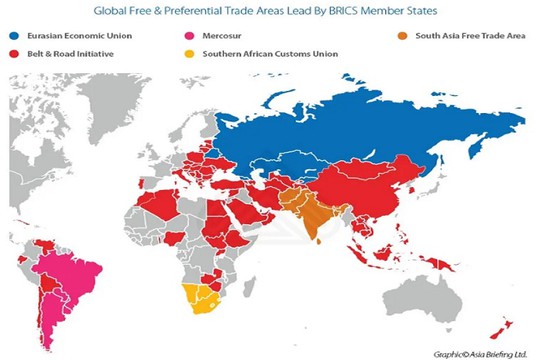Twenty two nations have formally applied to become members of the BRICS economic bloc, a South African diplomat said.
An equal number have also informally sought to join the organization that groups Brazil, Russia, India, China and South Africa, Anil Sooklal, the bloc’s ambassador from South Africa, told reporters in Johannesburg.
Sooklal has previously said that countries including Saudi Arabia and Iran have formally asked to become BRICS members, while countries that expressed an interest in joining include the United Arab Emirates, Algeria, Egypt, Bahrain, Indonesia and others.
Here is an overview of the history of the creation and practical actions of BRICS by Bloomberg:
- The BRICS group of emerging markets — Brazil, Russia, India and China, with South Africa added later — has gone from a slogan dreamed up at an investment bank to a real-world club that also controls a major development bank. It once might have seemed ironic to see Communist Party-ruled China embrace the Wall Street conceit. But now countries of all political stripes, including Iran and Saudi Arabia, are clamoring to join, setting up potential friction at the club’s Aug. 22-24 summit in Johannesburg.
- “BRIC” was coined in 2001 by economist Jim O’Neill, then at Goldman Sachs Group Inc., to draw attention to strong growth rates in Brazil, Russia, India and China. It was intended as an optimistic thesis for investors amid market pessimism following the terrorist attacks in the US on Sept. 11 that year. The four nations took the idea and ran with it. Their rapid growth at the time meant they had shared interests and common challenges. They were already cooperating in forums like the World Trade Organization and felt their influence in a US-dominated world order would be greater if their voices were combined. The first meeting of BRIC foreign ministers was organized by Russia on the sidelines of the United Nations General Assembly in 2006. The group held its first leaders’ summit in 2009. South Africa was invited to join at the end of 2010, extending membership to another continent.
- The biggest concrete achievements have been financial. The countries agreed to pool $100 billion of foreign currency, which they can lend to each other during emergencies. That liquidity facility became operational in 2016. They founded the New Development Bank — a World Bank-inspired institution that has approved more than $30 billion of loans for projects like water and transport infrastructure since it began operations in 2015. (South Africa borrowed $1 billion in 2020 to fight the Covid-19 pandemic.) They plan to discuss the feasibility of a common BRICS currency this year. Economically, Brazil and Russia’s natural resources and farm products make them natural partners for Chinese demand. India and China have weaker trade connections with each other, partly due to political rivalries and an acrimonious border dispute.
- Economically, China’s gross domestic product is more than twice the size of all four other members combined. In theory, that should give it the most sway. In practice, India — which recently surpassed China in population — has been a counterweight. To take two examples: BRICS has not formally endorsed China’s big development push called the Belt and Road Initiative, partly because India objects to Belt and Road infrastructure projects in disputed territory held by Pakistan, its neighbor and arch rival. On the New Development Bank, there’s no dominant shareholder: Beijing agreed to the equal holdings advocated by New Delhi. The bank is headquartered in Shanghai, but has been led by an Indian and now, Brazil’s former President Dilma Rousseff.
- Generally speaking, BRICS is similar to clubs such as the Group of 20 in representing a move toward a more multipolar world and away from one dominated by the US since the end of the Cold War, as exercised through clubs like the G-7 and World Bank. “Global South” isn’t a club at all but a term that’s gained currency in recent years to refer to relatively poor countries, also referred to sometimes as developing or emerging. It’s typically contrasted with a “Global North” composed of the US, Europe and some wealthy countries in Asia and the Pacific.
read more in our Telegram-channel https://t.me/The_International_Affairs

 11:36 24.07.2023 •
11:36 24.07.2023 •























